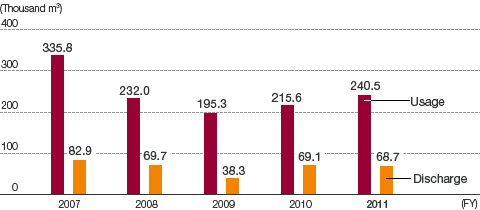 웹 내용 전시
웹 내용 전시

Basic policy
The Advantest Group promotes the "Three Rs" (reduce, reuse, and recycle) with the aim of realizing a recycling-based society. In addition, the Group is strengthening parts separation initiatives that were launched in fiscal 2009, promoting the recovery of valuable materials from waste while ensuring full compliance with all relevant laws and regulations, and conducting proper management and disposal of wastes produced by its business activities.
Volume of waste generated/recycling rate
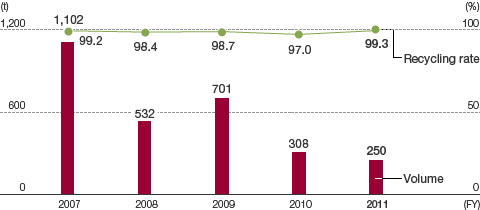
Recycling disposed-of hard disks through disassembly
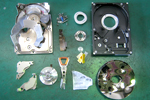
Disassembly of disposed-of
hard disk
From December 2011, the Advantest Group shifted from melting to disassembly as the means of processing disposed hard disks. In the previous processing method, aluminum was the only recyclable material. In contrast, the new method has enabled the recovery of gold, silver, copper, palladium and other precious metals, as well as rare earths such as neodymium magnet. This change has increased the value of disposed-of hard disks in terms of valuable materials, as well as preventing the generation of smoke that is caused by melting, allowing the Group to reduce its environmental footprint.
We will continue to process disposed-of hard disks through disassembly in the future, while prioritizing the prevention of confidential information leakage.
Waste reductions through the improvement of packaging from suppliers
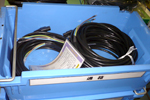
Packaging materials
(after improvement)
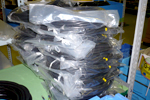
Packaging materials
(before improvement)
The parts warehouse division is working on improvements aimed at its must-achieve target of promptly and accurately supplying the production division with the required parts.
As a waste reduction initiative, we make proposals as needed to parts suppliers on packaging improvements in order to eliminate wasteful packaging, while taking into consideration the inventory turnover rate of parts and how the parts are stored. During fiscal 2011, we proposed deliveries using returnable containers based on the precondition of no quality issues being caused. By eliminating cardboard and plastic bags, we achieved a 50% reduction in man-hours spent removing and inserting parts, a reduction in wastes, and a reduction in packaging costs for suppliers.
We will continue to make improvements with the cooperation of parts suppliers in the future that are beneficial both in terms of the environment and costs.
Initiatives to reduce packaging materials in logistics activities
From February 2011, the Group began shipping production components to overseas production bases. In the beginning, one shipment was made per shipment to improve productivity at local production bases, and over 10,000 components were shipped as separately packaged units. Load efficiency was very poor under this system, and we used approximately 40 reinforced cardboard sleeve boxes sized 120 cm x 200 cm x 130 cm and approximately 140 cardboard boxes sized 70 cm x 43 cm x 34 cm (total use was about 1,173 m2) for one shipment.
Packaging improvements were made in response to this issue, in which packaging boxes best suited to the sizes of components were created, and an original system using a bar code reader was adopted to make it easy to conduct searches to identify which components are contained in each outer box and cardboard box and what system the components would be used for.
As a result, packaging by unit is no longer necessary and it is possible to use efficient boxes that match the sizes of components. This initiative has reduced the number of reinforced cardboard sleeve boxes per shipment from 40 boxes to 10 boxes, and reduced the number of subdivided cardboard boxes from 140 boxes to 40 boxes, as a result reducing the amount of cardboard used per shipment from 1,173 m2 to 314 m2. As of May 2012 we have achieved a total cardboard reduction of 18,000 m2.
Initiatives to reduce packaging materials
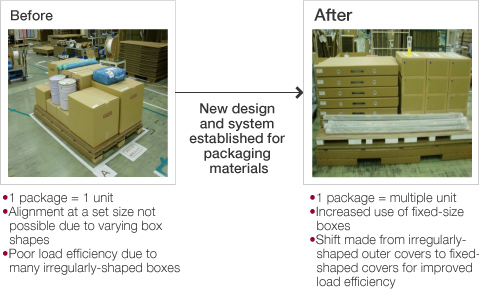
Effective utilization of water resources
The Group's production process consists mainly of assembly, adjustment, and inspection, and does not require as much water as typical manufacturing processes. The majority of the water used at the company is for air conditioners, kitchens, toilets, and consumption.
During fiscal 2011, we prioritized energy saving measures as one of our most important environmental activities due to the power shortages caused by the Great East Japan Earthquake. In line with this priority, we sprinkled water on roofs and walls during the summer in an initiative aimed at making it possible to spend a cool and comfortable summer using less electric power. When water is sprinkled on roofs, heat vaporization causes the indoor temperature to decrease in the rooms directly under the roofs on top floors. As a result of this initiative the amount of water consumption increased 12% year on year to 240.5 thousands m3 for fiscal 2011.
We plan to use water in the same manner in fiscal 2012 in order to save energy. We will consider initiatives that will allow us to use water as efficiently as possible, such as reviewing air-conditioning operations and promoting water conservation activities that each and every one of our employees can participate in.
Water consumption and discharge
